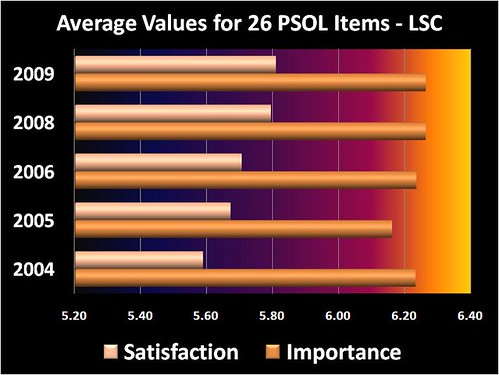 Listed below are the 12 largest gaps out of the 36 items in the PSOL for Lake Superior College in spring 2009. The difference between importance and satisfaction as rated by the students is known as the gap, which represents the amount of improvement needed in your satisfaction score to bring it up to equal the importance score. Gap analysis is a way of concentrating your improvement efforts in the right areas to maximize value for students.
Listed below are the 12 largest gaps out of the 36 items in the PSOL for Lake Superior College in spring 2009. The difference between importance and satisfaction as rated by the students is known as the gap, which represents the amount of improvement needed in your satisfaction score to bring it up to equal the importance score. Gap analysis is a way of concentrating your improvement efforts in the right areas to maximize value for students.
CC photo by Joe Shlabotnik
| FY09 PSOL (Priorities Survey for Online Learners) | LSC Students | ||
| Item – Gap: high to low | Import. | Satisf. | Gap |
| 20. The quality of online instruction is excellent. | 6.56 | 5.68 | 0.88 |
| 12. There are sufficient offerings within my program of study. | 6.44 | 5.58 | 0.86 |
| 09. Adequate financial aid is available. | 6.46 | 5.66 | 0.80 |
| 06. Tuition paid is a worthwhile investment. | 6.55 | 5.77 | 0.78 |
| 32. Layout of courses, as designed by instructors, is easy to navigate and understand. | 6.60 | 5.83 | 0.77 |
| 11. Student assignments are clearly defined in the syllabus. | 6.51 | 5.80 | 0.71 |
| 05. My program advisor helps me work toward career goals. | 6.11 | 5.40 | 0.71 |
| 33. Instructions to students on how to meet the course learning objectives are adequate and clearly written. | 6.58 | 5.90 | 0.68 |
| 07. Program requirements are clear and reasonable. | 6.50 | 5.82 | 0.68 |
| 35. Instructional materials have sufficient depth in content to learn the subject. | 6.54 | 5.91 | 0.63 |
| 30. Interactions I have with online instructors are useful to me in the learning process. | 6.46 | 5.84 | 0.62 |
| 22. I am aware of whom to contact for questions about programs and services. | 6.28 | 5.68 | 0.60 |
Many schools have gaps above 1.0, but we typically (in 5 years of surveying) have not had any gaps that large. Still, it is important for us to focus on a few areas each year for targeted improvement. In order to achieve an improvement in the survey scores over time, a couple of factors need to be present:
- the item needs to be something that you have some control over or can influence where that control is held
- the item needs to be controllable in the short-term (if you want to see reportable improvements in the next year or two)
- the item needs to be something where the cost of achieving the improvement is less than the benefits to be received, if possible
For example, item #9 is the statement that “Adequate financial aid is available.” Although we might be able to add another scholarship or two to those already offered, we really don’t have much ability to make a difference in the amount of financial aid available to students. So, although it’s nice to know what they think about the availability of financial aid, there’s little we can do about it. That is not a gap that we (as an institution) can do much about. However, the Feds and the State of Minnesota sure could make a difference there if they wanted to help educate the populace.
On the other hand, there are five items in this top 12 list which could be targeted for improvement with a major campaign to help faculty improve these items in their courses:
- #11 – Student assignments are clearly defined in the syllabus.
- #30 – Interactions I have with online instructors are useful to me in the learning process.
- #32 – Layout of courses, as designed by instructors, is easy to navigate and understand.
- #33 – Instructions to students about how to meet the course learning objectives are adequate and clearly written.
- #35 – Instructional materials have sufficient depth in content to learn the subject.
Our online faculty peer review process absolutely makes a difference in items 32, 33, and 35 shown above. In fact, I shudder to think how large the gap might be if we didn’t have that process in place and if we hadn’t made good progress over the past several years. Still, not all faculty participate in the voluntary process, and not all courses have been reviewed. Therefore, we have the opportunity to encourage all online faculty to consider spending some time to beef up these areas, and of course we can provide some professional development opportunities to help them do so. By doing so, we should also help make a difference in the largest gap on the list, item #20.

